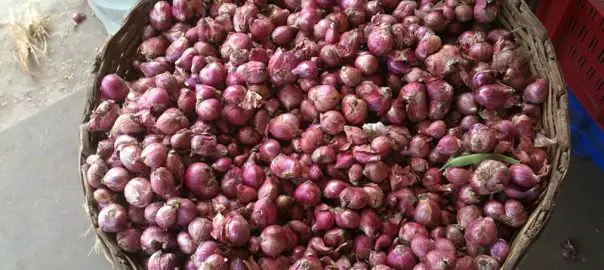Shallots probably originated in Central or Southwest Asia, traveling from there to India and the eastern Mediterranean.
The name “shallot” comes from Ashkelon, an ancient Canaanite city, where people in classical Greek times believed shallots originated.
Shallots are used in fresh cooking in addition to being pickled.
Finely sliced, deep-fried shallots are used as a condiment in Asian cuisine, often served with porridge.
As a species of Allium, shallots taste somewhat like a common onion but have a milder flavor.
Like onions, when sliced, raw shallots release substances that irritate the human eye, resulting in production of tears. (source)
Can guinea pigs eat shallots?
Let’s take a look at their nutritional data and find out more.
In particular, their acidic, water, sugar, fat, salt, calcium and phosphorus content is of most interest as far as guinea pigs are concerned.
Nutritional value per 100 g (3.5 oz)
Energy 301 kJ (72 kcal)
Carbohydrates
16.8 g
Sugars 7.87 g
Dietary fiber 3.2 g
Fat
0.1 g
Protein
2.5 g
Vitamins
Thiamine (B1) (5%) 0.06 mg
Riboflavin (B2) (2%) 0.02 mg
Niacin (B3) (1%) 0.2 mg
Pantothenic acid (B5) (6%) 0.29 mg
Vitamin B6 (27%) 0.345 mg
Folate (B9) (9%) 34 μg
Vitamin C (10%) 8 mg
Vit E (0%) 0.04 mg
Vitamin K (1%) 0.8 μg
Minerals
Calcium (4%) 37 mg
Iron (9%) 1.2 mg
Magnesium (6%) 21 mg
Manganese (14%) 0.292 mg
Phosphorus (9%) 60 mg
Potassium (7%) 334 mg
Zinc (4%) 0.4 mg
source wikipedia
As you can see, shallots contain quite a lot of phosphorus and acidic content, a little calcium, quite a bit of sugar and a hint of fat.
This means that unfortunately, guinea pigs cannot eat shallots. They are too acidic for guinea pigs to eat and will make them unwell if they are eaten.
They should be avoided as a food for them and they shouldn’t even nibble them.
If they do happen to nibble one, keep the piggie under close surveylance and check for any symptoms of unwellness.
If they take turn for the worse, then consider taking them for a veterinary surgeon check up.
What other veggies could guinea pigs eat in their place?
There are many other veggies that guinea pigs could eat in their place, for instance bell peppers, carrots, kale, spring greens are great for guinea pigs to eat.
They give them the nutritional value that guinea pigs need and provide a healthy back up for their main staple diet of hay, guinea pig mix and water along with fruit.
A good balanced diet is great for a guinea pig and their long term well being.
They love vegegables and will eat them all day, however, they aren’t the best to be be eaten all of the time though.
For more foods that guinea pigs can and can’t eat, check out our guinea pig food list.

